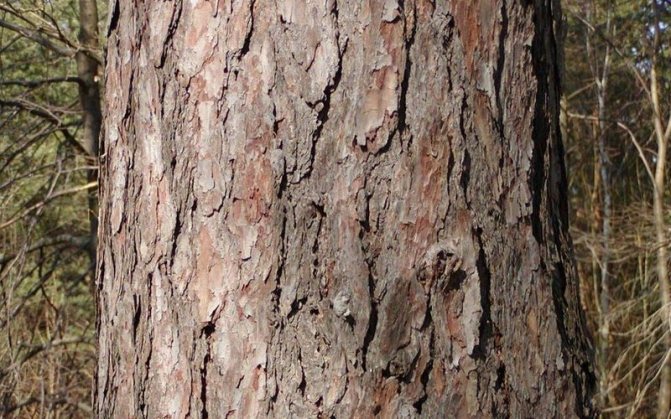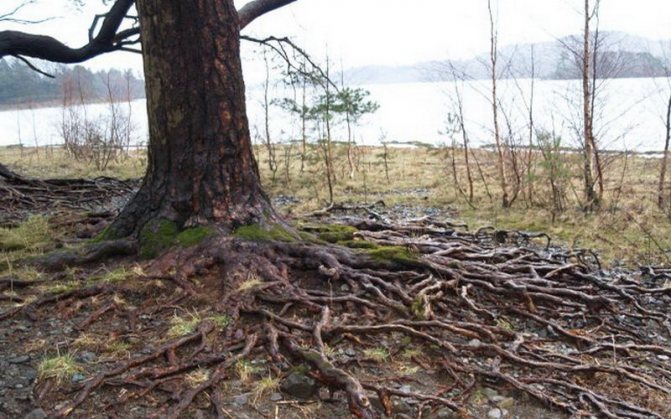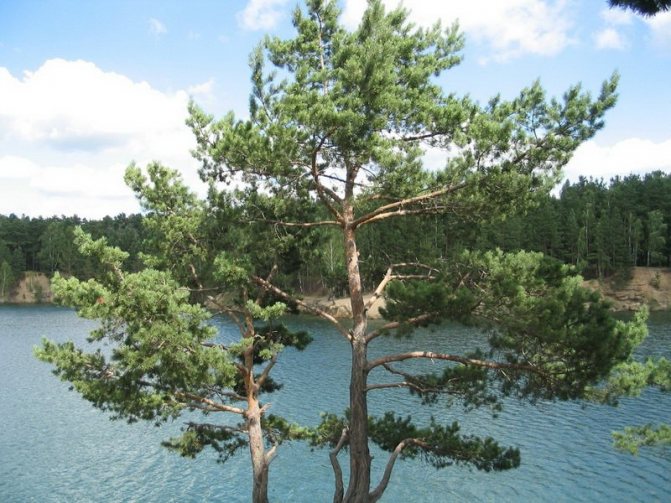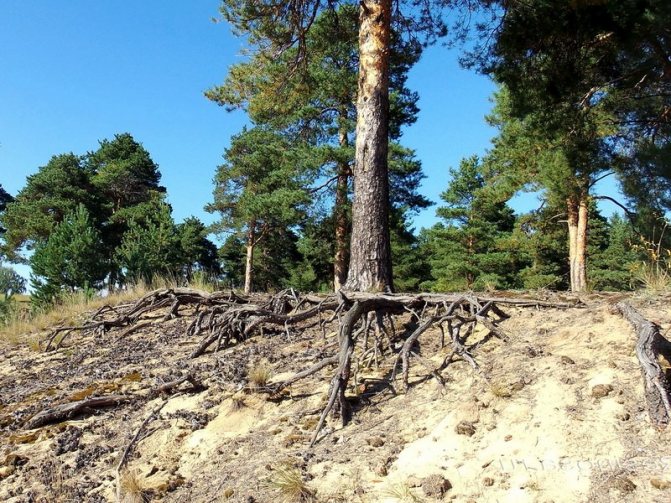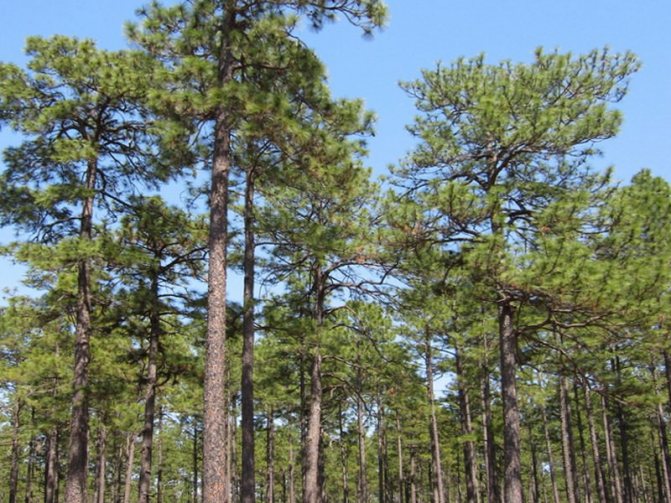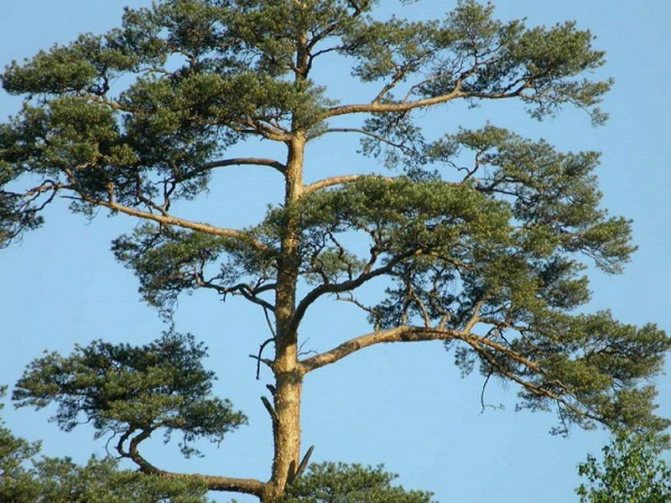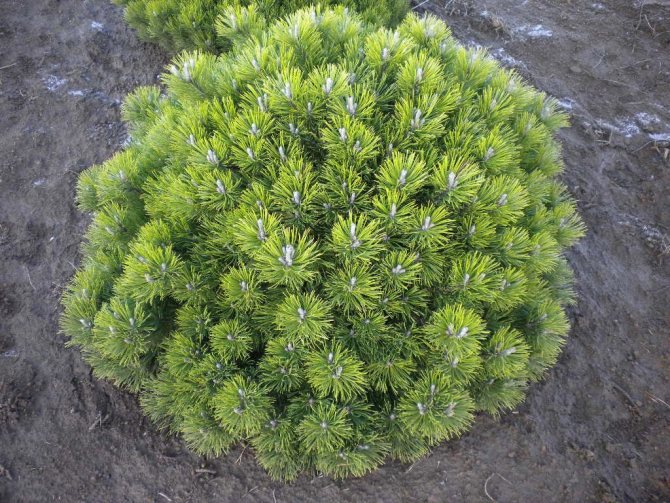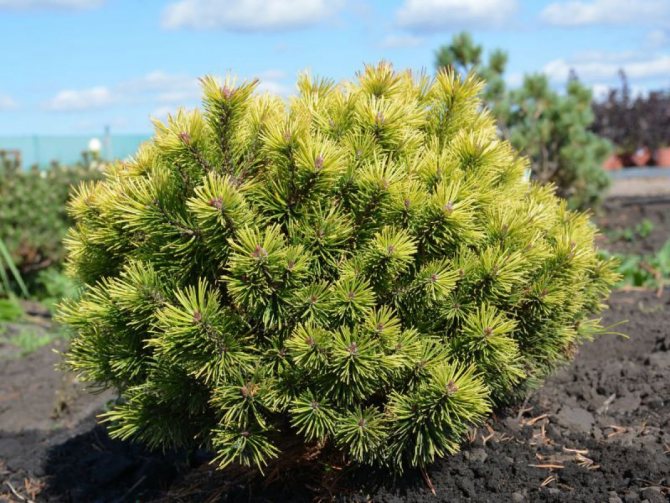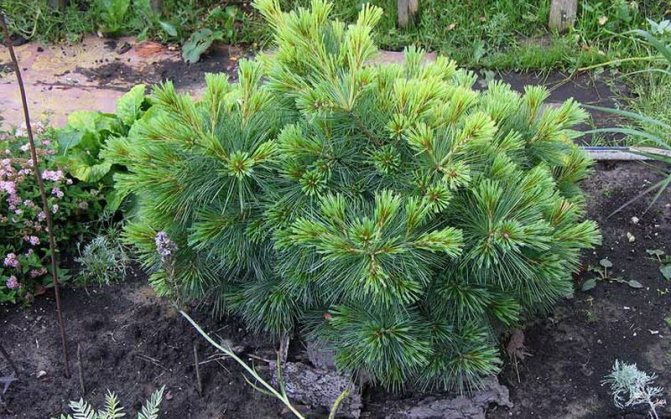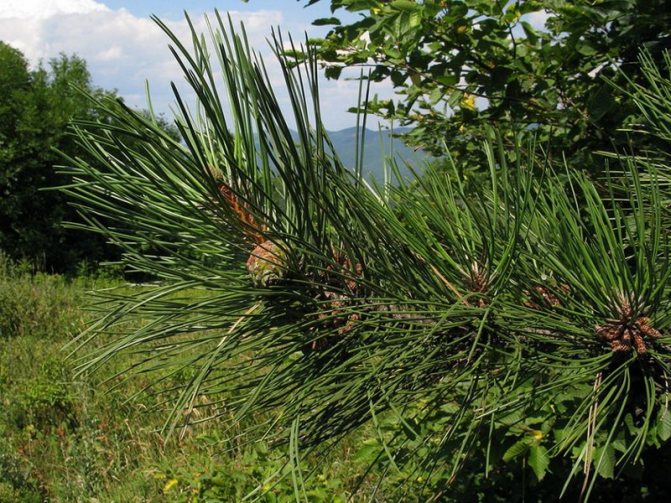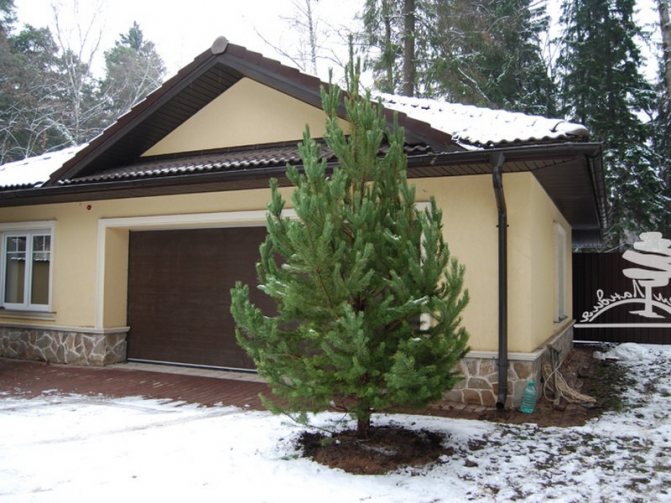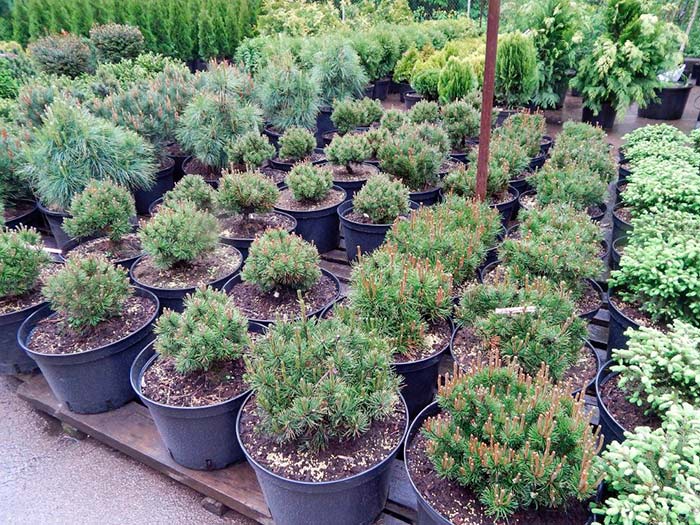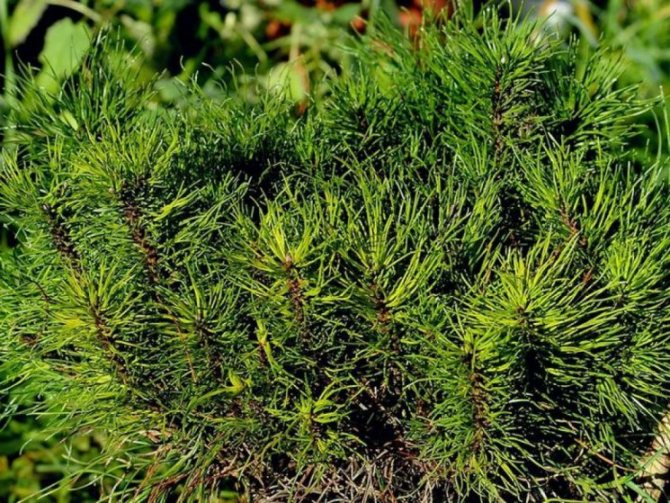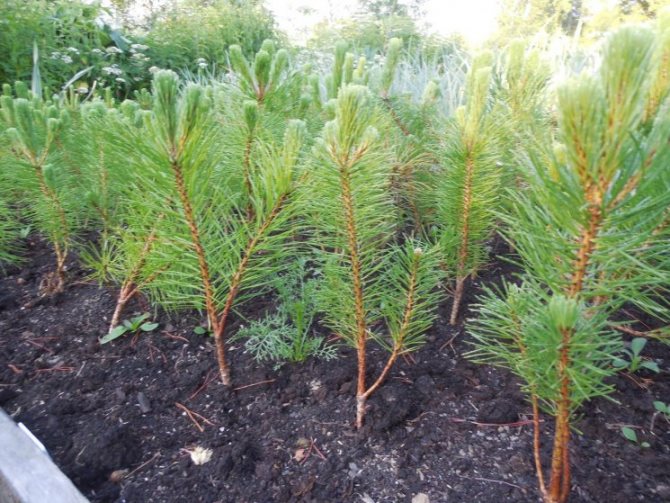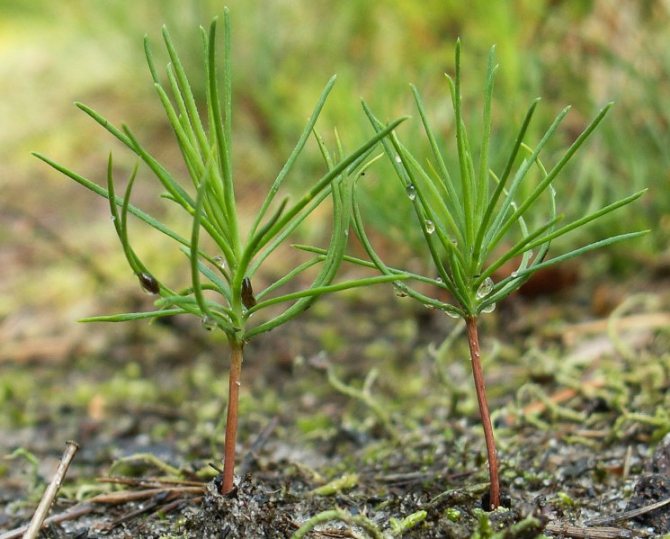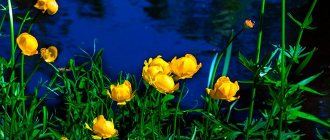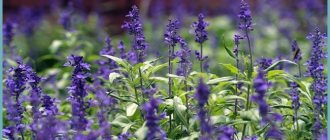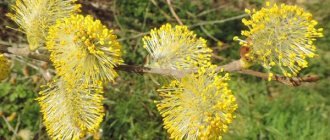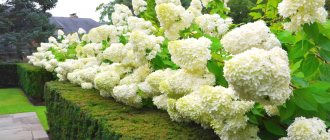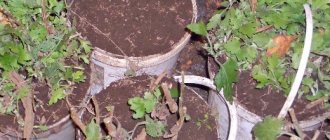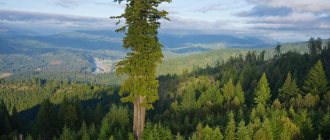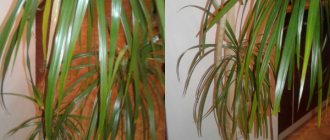The culture belongs to the European dwarf pine species, the international scientific name is Pinus mugo Turra. It is used for protective, reinforcing plantings, landscape decoration, covering slopes and slopes. Mugo mountain pine wood is used for turning and joinery products. Young shoots, cones are used in cosmetology, medicine, oil is obtained from seeds.

Choosing a place for planting Scots pine
So, first, the site of planting of Scots pine is determined. During the choice, it is worth considering the fact that the tree grows quite quickly, with a favorable set of circumstances, the growth can be 35 cm per year. The height of an adult tree reaches 20-40m in height. And the less sun the tree gets, the higher it will be. Therefore, in order to obtain and preserve for several decades a low plant with a spreading lush crown, a place must be chosen in an open sunny area. Remember that it is almost impossible to stop the growth of a pine tree. It is possible to limit the growth of the tree upward and force it to stretch out in breadth, if at the end of May - beginning of July, cut off some of the young shoots when they are in the form of "candles".
Pine crown formation
Pines can be shaped in different ways, depending on the goal. Most often, Scots pine is subjected to shaping. Under natural conditions, this tree can reach very large sizes, but on a personal plot this is not always appropriate. By shaping, you can significantly slow down the growth of the plant, at the same time giving it a fluffier appearance. The fact is that after the pinching, much more buds are laid on young shoots, which will turn into shoots next year.
The formation of the crown is carried out by the pinching method - the secateurs are never used, if only you need to remove any branch entirely. In the spring, when the young candles move to their full length, but the needles have not yet moved away from the shoot (this usually happens in May), you need to pinch the shoot to the required amount with your hands - 1/3, 1/2 or 2/3. Do it with a twisting motion.
After 2-3 weeks, the pines are examined again for additional adjustments. If some shoots have stretched out during this time and disturbed the overall picture, they are pinched or, if necessary, removed completely. It is better to carry out this procedure with gloves, since the escaping resin is poorly washed off.
With the help of shaping, you can not only correct the crown - trim some crooked or bare areas, but also give the pine a completely exotic look. Creative gardeners, using different methods of formation, turn their tree into a ball on a stem or a real Japanese bonsai.
Young shoots are quite elastic and they can not only be pinched, but also bent in the right direction. By fixing the branches in an unnatural position, you can give the pine a mysterious, fabulous look. True, this will take years, as well as the creation of any deciduous bonsai. Therefore, this activity is only suitable for a patient gardener. For those who want to make it both quickly and beautifully, there are just different types and varieties of pines that rarely need shaping.
Seedling selection
When choosing a seedling, it is necessary to pay close attention to the preservation of the earthen coma. Saplings with a bare root system are doomed to death, since the suction roots growing from the main root and feeding the entire tree die with a lack of moisture after 15 minutes and cannot be restored.
If you are not going to plant a large-sized plant (a plant with a height of more than 3 meters), then the ideal time for planting pine will be the period from late April to late May, or you can postpone this event to late summer - early autumn. Such time intervals are due to the need to adapt the plant to new conditions before the onset of frost. If the tree is planted in late autumn or early winter, then the space near the trunk must be covered with spruce branches to prevent frosting of the roots and the death of a plant that has not yet taken root.
Combination with other plants
Pine Mugus is actively used both as the main and as an auxiliary decorative element in landscape design. With the help of mountain pine, slopes are often strengthened and greened. Also, shrubs are quite often used in combination with birches, larch and other conifers for landscaping areas, creating hedges and strengthening the soil.
The different varieties of Mugus pine are excellent for container planting. It can be used in combination with small bush flowers to create rocky gardens.
That's all, in fact, that you should know in order to successfully grow a worthy representative of conifers on the garden plot. Good luck!
Planting pit
Before planting, pay attention to the soil of your site. If the earth is clay or loam, then the pit requires a good twenty centimeters drainage from chipped brick or medium-sized expanded clay, it is worth filling it with a mixture of fertile soil and sand. And so that the drainage pit does not turn into a drainage pit for your site, choose a place on a hill. To ensure good development of the tree, complex fertilizer should also be poured into the pit. After the hole is filled up, the soil should be watered abundantly. As a rule, no further watering is required.
Pine in landscape design
Today, ornamental plant nurseries have a rich assortment of different types and varieties of pines. Plants differ not only in the color of the needles, which can vary from emerald green to golden. The shape of the crown, the length of the needles and the height of the tree are also the hallmarks of one type or another.
Landscape designers, taking into account and successfully selecting various varieties, sometimes create real masterpieces. Pine is undemanding to soils, tolerates severe frosts and drought, besides, all types of this tree are real long-livers. Therefore, landscapes created once will delight the eye for many years.
When creating landscape compositions with pine trees on the site, pay attention to the material: Flower garden with conifers - the rules of organization and the choice of plants.
Not everyone can afford the services of a designer, but an ordinary amateur gardener can easily create a harmonious coniferous composition. To avoid mistakes when creating a landscape, you need to know 10 simple rules for placing pine trees on the site:
- When planting, take into account the height of an adult plant.
- The distance from the pine tree to the place from where it can be observed should be 2 times the height of the tree itself.
- If there is little space on the site, you can create a composition of medium-sized and dwarf pines.
- The pine tree looks beautiful when the rays of the rising or setting sun fall on it - if there is such an opportunity, it is better to take this property into account.
- With a single arrangement, it is better to sow the soil surface around the pine with a lawn - this is how the ephedra looks most impressive.
- A pine planted near a pond looks good, especially in the company of weeping deciduous trees.
- Depending on the size of the plot, you can create compositions by combining pine trees of different shapes and heights - high views in the background, low and creeping ones in the foreground. Horizontal junipers or decorative deciduous plants - hosts, ferns, lily of the valley - look good as the lower tier.
- Pine trees planted at a young age adapt well to the characteristics of the site. This property can be used when planting them in places with high groundwater levels. For a pine, an ordinary pit with drainage will be enough, and the root system itself will choose a favorable position for itself - in this case, superficial.
- When planting plants with different colors of needles, in order to maintain the style, they use the rule - if the composition consists of three plants - there should be no more than two flowers, if 5-7 conifers are planted, it is permissible to use three colors.
- In order for the pine to look beautiful both in winter and in summer, you need to choose frost-resistant plants that do not need winter shelter. After all, even the prettiest covering material will disturb the perception of a live ensemble.


Modern pine varieties can have needles not only green, but also golden (almost yellow).
Scotch pine care
Scots pine does not require special care, but like other conifers, it can be damaged by diseases, so you need to look closely at it from time to time. One of the most common diseases is rust, which can be eradicated by systematically collecting yellowed needles and treating the trunks with a zineb suspension. Also, aphids, scale insects and ticks can attack the pine, karbofos will help from them. Pine branches often infect moths and silkworms. The only way to combat them is to remove branches infected with clutches.
Best-
The healing properties of pine
Possessing great vitality, the pine contains a storehouse of healing riches. And needles, and juice, and buds, and wood - everything in the pine heals, heals, goes into action. The pine needle extract is used for life-giving baths.
Pine sap - resin, - containing rosin, is a raw material for the manufacture of ointments, plasters. Turpentine obtained from it is an excellent external remedy for neuralgia, rheumatism, gout. Pine inhalation cures the most persistent cough and laryngeal catarrh by acting as an antiseptic.
The tar used in the treatment of skin diseases - scabies, eczema, neurodermatitis also has a disinfecting effect.
The shortened apical shoots of pine (buds), which must be harvested in February - March, before they start growing, have expectorant and disinfectant properties. The healing properties of pine are used for colds, bronchitis and even tuberculosis.
Some pine species have large, edible seeds that are rich in fatty oils and proteins.
Video: Pine cones, harvesting
Next, you will learn what types of pines are, and what are their features.
Pines are descendants of Pitis. Pine planting, cultivation and care
According to one ancient Greek legend, pines originated from the nymph of the morning dawn - Pitis, who turned into a pine tree to hide from the claims of the god of the north wind Boreas. Well, her descendants are clearly a success. Like other conifers, pine secretes phytoncides, which have a beneficial effect on the nervous system, respiratory tract, and also cleanse the surrounding air from harmful bacteria and fungi. And the enchanting aroma and bewitching energy of pines simply defies description.
Pines are winter-hardy plants, they tolerate low air humidity well. Most types of wood are resistant to environmental pollution (unfortunately, Scots pine cannot boast of this). Unlike other conifers, pine grows best in permanently lit areas, it is an extremely light-loving plant.
For planting, it is best to choose sandy and sandy loam soil, but if you are planting the plant on heavy soils (such as loam and clay), you will need additional drainage of the site. For this purpose, expanded clay, sand and fragments of broken bricks are suitable. It is desirable that the drainage layer in the planting pit is at least 20 cm. For black and Weymouth pine, an alkaline or acid-neutral soil is required. You can get rid of excess acidity with the help of lime - just add about 300 g of lime to the planting pit, and then mix it with the soil.
For planting, it is best to choose seedlings from 3 to 5 years old. We would not recommend grabbing a shovel and running to dig out any pine tree in the nearby forest - with such transplants, plants very rarely take root and usually die the next year after planting. It is better to buy a ready-made seedling in specialized nurseries. There are several advantages to such a purchase: in addition to the seedling itself, you can get additional advice on planting and caring for it, and leave the tree that was not dug out in the forest alive :)
Such pine seedlings are planted in late April or early autumn. Before planting, it is necessary to prepare a hole up to 1 m deep. A mixture consisting of turf soil, topsoil, river sand or clay (in a ratio of 2: 2: 1) is added to the planting hole. We also add some nitrogen fertilizers, about 30-40 g.
When planting a seedling in a prepared hole, it is necessary that the root collar of the tree is at ground level. If not one, but several trees will be planted, as much space as possible should be left for them: trees of low-growing species are planted at a distance of 1.5 m from each other, it is advisable to observe at least a 4-meter interval between large trees.
Reproduction of pine
Usually pine seedlings are obtained by seed propagation. Other methods, such as propagation by cuttings or grafting, are not effective enough.
Pine propagation by seeds
If you want to go all the way from A to Z when planting, you can try growing pine from seeds. You can plant pine seeds in open ground or in specially prepared boxes. Better, of course, is the second option: seeds planted in open ground can be destroyed by rodents.
Pine seeds do not need additional stratification. Although it is possible to accelerate seed germination by using a change in ambient temperature. As with most other plants, pine seeds will germinate faster when it gets warmer. It is easy to arrange an artificial temperature contrast for the seeds: for this, before planting, it is enough to put them in the freezer for a short time, and then rinse them in warm water.
The boxes in which you want to plant the seeds can be of any material, they must have holes in them to drain excess moisture. The soil in the box itself should be loose, sprinkled with peat on top. Peat is necessary for the prevention of fungal diseases that affect young pine seedlings. We sow the seeds shallowly, it will be better to just pour them onto the prepared soil, and then loosen it. The interval between the sown seeds should be at least 5 mm: if this is not done, the germinated seedlings will raise the ground, while the delicate roots of the seedlings will dry out.
After a year, the seedlings can be transplanted to a permanent place, the best time for transplanting is April or May.
Pine tree care
Pruning
Pines do not need a special shearing. If you need to slow down the growth of a tree and want the crown to be thicker, then it is enough to break off the young branches with your fingers about a third of their length.
Watering
Almost all types of pine do not need additional watering, this is an extremely drought-resistant plant, and the fallen needles under the tree helps to retain moisture. The exception is the Rumelian pine.This is a moisture-loving tree, it must be watered 2-3 times per season (about 15-20 liters per plant).
You will also need additional autumn watering (after the end of leaf fall) newly planted seedlings. Moist soil freezes less, so the risk of burning needles in the spring (and this is possible, the crown of pines wakes up early, and because of the frozen soil, the roots of the plant do not provide enough moisture) will be much less.
Top dressing
Top dressing is necessary for young seedlings in the first two years after planting. To do this, mineral fertilizers (approximately 40 g / sq. M) are applied to the under-trunk circle of the tree at least once a year. In the future, for the normal development of the pine, there will be enough organic fertilizers accumulated in the coniferous litter under it.
Shelter for the winter
Adult trees are winter-hardy, but young pines (and some ornamental species) should be covered for the winter to avoid sunburn. For this purpose, spruce branches are used. They cover the crowns of seedlings at the end of autumn and do not remove it until mid-August. Also, as an option, you can use rare burlap or special covers. It is impossible to wrap trees with thick material or polyethylene - such "protection" will lead to damping out of seedlings.
Types and varieties of pine
The variety of types of pines and their varieties used for decorative purposes is very extensive. We have no way to describe everything, so we will try to show you the most interesting and attractive species of this tree.
The most common type of tree, unpretentious to soil fertility. This pine grows quickly, loves well-lit places. Winter hardiness. The biggest disadvantage is that Scots pine is sensitive to air pollution.
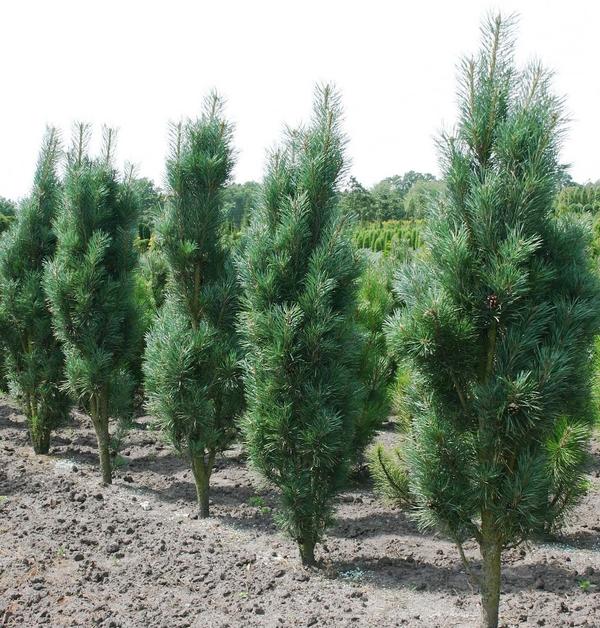

The tree grows up to 40 m high, the crown is narrow-pyramidal and dense. The bark is at first smooth, gray-brown in color, with a swell it becomes scaly and rough. The needles are dense, the needles are dark green.
A small creeping plant, branches are widely scattered. The crowns of trees may differ in appearance - there are creeping, tree-like and bowl-shaped. With a tree-like crown, elfin wood grows up to 5-7 m in height.
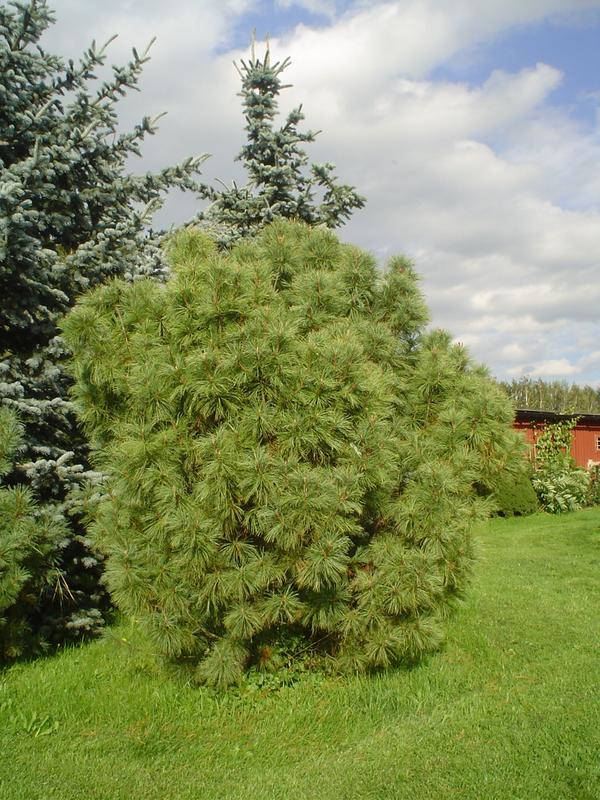

Like Scots pine, this species is winter-hardy, drought-resistant. The composition of the soil is also undemanding, mountain pine is not damaged by diseases and pests. Frosts and snowfalls are also not scary to her. It goes well when planted with birches, larch, Balkan pine and spruce. A large number of decorative varieties have been bred.
Finally, it should be noted that recently pine has been in demand not only for the New Year holidays :) More and more summer residents are planting pine trees on their suburban area, enjoying their beauty and aroma. Maybe you should get yourself a couple? 

Violetta Shevchenko, Rostov-on-Don
How I love pine trees! On the site, of course, I will not plant - I like the pine forest, but for him my lands are too small :)) But taking a walk in such a forest is a fantastic pleasure! A little in a good way, I envy the inhabitants of those regions where pines grow everywhere. Since childhood, I remember a summer vacation at a dacha near St. Petersburg, where pines surrounded the village, grew right behind the fences of the plots; Karelian Isthmus, where pine trees surrounded by mossy boulders gaze into endless lakes ... Nostalgia :)
And in my dacha there are two pines of 20 years old - they were planted with twigs - one-year-olds, unfortunately, one died at the age of 5 years. and one - she is waiting for a transplant for 3 years, this fall she did not have time to transplant. I wonder if it is necessary to cut the lower branches - they are at a height of 20 and 50 cm. We could not find an answer.
Mountain pine: description of the plant
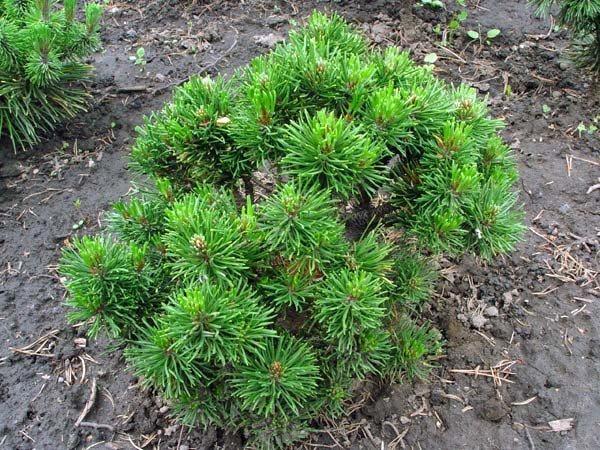

Mountain pine (Pinus mugo) is a shrub species of dense pine, although trees are more common in the wild.
The shrubs reach a height of 4-5 m, and the trees - 7-8 m. The shoots of the mountain pine are short, creeping along the ground and curved towards the top.The root system is superficial, highly branched. The needles are dark green in color. The length of the needles is up to 4 cm. They are collected in bunches of two pieces, slightly twisted. Their lifespan is 3 to 5 years. At the age of six to eight, cones appear on the pine, which add decorativeness to the tree. They are cone-shaped, light brown in color, 3-6 cm in length.
Did you know? The existence of small conifers with slow growth has been known since the 17th century. The mountainous areas of Central and Southern Europe are considered their homeland. Later, Pinus mugo spread in horticultural culture all over the world.
The Pinus mugo pine has a number of advantages:
- has a good degree of winter hardiness;
- drought-resistant;
- wind resistant due to its strong root system;
- has strong branches that do not break off under the snow cover;
- undemanding to the composition of the soil;
- tolerates pruning well;
- less than other types of pines are affected by diseases and pests;
- suitable for planting in urban areas, resistant to air pollution;
- long-liver - can live 1000 years.
Mountain pine propagation occurs in three ways: cuttings, grafting and seeds. Ephedra is characterized by slow growth rates: annual growth is 10 cm in height and 15 cm in width. At the age of ten, the tree reaches a maximum height of 0.6-1 m, with a diameter of 0.6-1.8 m.
how to care for pine pinus pinea silver crest cultivar
Linda
Strictly speaking, this is a piniya. The pine can be grown in a container in the garden so that in the summer it gives a special accent to the plot, and in the winter it can be brought to a warmed loggia or a winter garden. Then, for the Christmas holidays, the Italian pine tree will become a wonderful home decoration. The plant is quite easy to care for. From May to September, she spends time on the sunny terrace, sheltered from the wind. The plant has long roots, so provide an ample container for growth. In summer, watering should be regular and abundant. To strengthen the needles, a little fertilizer for conifers is added to the irrigation water once every 3 weeks. But it must be borne in mind that pine cannot be overfed, since under natural conditions it grows on poor sandy soils of mountainous regions. With the onset of a cold snap in October, transfer the pine to the loggia or to the greenhouse. From October to April, no top dressing is carried out, they maintain a constant soil moisture, but the roots cannot be poured. In winter, Italian pine can be outdoors only on warm days when protected from the cold wind. For planting a plant, light, permeable compost soil is suitable. Young plants require an annual transplant, mature plants are transplanted as needed. When the soil dries out, the needles may shatter; it is very difficult to save such a plant. Move it to a cooler area and water it regularly. If the needles are yellower at the bottom, but the plant itself is growing, then this may be due to insufficient lighting, too abundant feeding, excessive soil moisture.
- it's simple. But first we need to decide what to plant, where to plant, and how our garden should look like in three years and in twenty years ...
Summer. The resinous smell of pines heated by the sun ... Winter. Green pines under fluffy caps of snow ... Here is my idea of the earthly paradise. And, like any idea of paradise, it should be realized at the summer cottage. Is it the same for you too? Then I propose to discuss the pressing issues of pine bushes.
Before planting, you need to decide on the type of pine. Actually, there are only two main options here - Scots pine
(or extraordinary) stout and
mountain pine
... The compromise option is
cedar pine
.
Sold in almost any garden center. Prices for small pieces are quite affordable. Mountain pine comes in different shapes and sizes in adulthood: small tree, branchy bush, ground cover forms. The choice is yours.
pros
: compact and branching to the base. Without any inhibition of growth, even in adulthood, they do not clutter up the site, do not fly up, breaking wires, darkening the beds and inviting the owners to admire only bare trunks.
Minuses
: slow growth. This, of course, is the flip side of compactness, but, you must agree, I would like to see the site in a "completed form" within a reasonable time, as planned by the design project (just kidding).
Another minus, but this is my personal opinion, is the inability to experiment and participate in the formation of the tree. I have two mountain pines. I love them. They live remarkably well without my participation (except for weeding).
Cedar pine
Planting a pine (transplant)
It is better to replant pines in spring or, at least, in the first half of summer.
The most important thing is to dig the pine tree correctly. Don't choose a large plant. The younger the tree, the more likely it is to undergo replanting. It must be remembered that pine has a taproot. Having dug around the tree, I stick my hand under it, trying to find the taproot so as not to chop it. It is necessary to transplant the pine tree with a lump of earth. Even if the lump has fallen apart and the roots are bare, I quickly sprinkle the roots with earth from under the pine tree. It is believed that conifers live in symbiosis with soil fungi, form a fungus root - "mycorrhiza". Therefore, the more "native" land is in the planting pit, the better the pine.
In my opinion, pines are indifferent to soil fertility. I successfully transplanted them into acidic peat soils and heavy loams. The sun is important for the pine. In the shade, she stretches out and does not show all her fluffy beauty.
For a pine, as for any tree, you need to dig a planting hole, carefully spill it with water, pour it on the bottom of the forest land, insert a tree, sprinkle the roots with forest soil, and then garden soil. Be sure to stamp the ground around the trunk to avoid air pockets around the roots. And water thoroughly again. Remember to shade the tree for a few days and water it frequently throughout the season, especially in heat and dry conditions.
Planting of Scots pine seedlings (with a clod of earth). The recommended planting time for seedlings (seedlings) is usually spring, before the beginning of growth (vegetation) and autumn, from the beginning of September, and the autumn planting ends before the onset of cold weather (in the Moscow region until the end of November). Large trees (over 3 meters high) are recommended to be planted from November to March. The optimum acidity for pine (cedar, larch) is pH 6-7. Strongly acidic or alkaline environments inhibit plants and promote infection. Acidic soil can be improved by watering with ash water; prepare it by pouring a bucket of hot water into a faceted glass of wood ash and infusing it for a day. Alkaline soil can be neutralized with peat broth: a glass of peat chips is boiled in 1 liter of water for 20 minutes, filtered, stored in glass bottles; before use, a teaspoon of the broth is dissolved in 200 ml of water. Preparing potting soil. The soil from the holes is mixed with peat, humus is added - rotted manure, wood ash, possibly 3-4 handfuls of forest litter from a coniferous forest. This contributes to the better development of mycorrhiza on the roots (symbiosis of root ends and hyphae of forest fungi), which provides good mineral nutrition for conifers in the future. Optimal proportions: 3 earths (sand + clay), 1 peat, 1 humus, 0.5 ash, 0.5 earth from the forest, or perhaps a ratio: 3 earths (sand + clay), 2 humus or peat. Landing. Pine is very light-requiring. Be sure to choose an open, unshaded place for planting! - Prepare-dig holes in advance, top diameter 40-60 cm, bottom diameter 30-50 cm, depth 60-80 cm., For heavy earth, place "drainage" on the bottom - ASG or expanded clay or crushed stone with a layer of 10-20 cm, add hole with soil mixture (see.above), so that the surface of the ground in the container coincides with the surface of the ground at the planting site (be sure to take into account the shrinkage of the soil), pour out 5 liters. water into the hole. When digging a hole, a small earthen dump is made from the sod around the seedling 50x50 cm in size.This will retain water when watering. - Deliver the plant to the hole. - Carefully place the root ball in the hole. The plant is placed in the hole as it is convenient, it is important to align the trunk vertically on all sides, fill it up, not strongly ramming the root ball with the "mixture" (or) soil. During the first year after planting, the soil in the holes will settle. You can also additionally mulch (sprinkle after planting around the root collar) with sawdust or pine bark. It retains moisture in the soil, raises the temperature of the soil, enriches it with nutrients. Landing scheme. It is recommended to plant in rows along sidewalks, fences, roads. With a distance between trees in a row from 3 to 5 meters, but not less than 1m. Additional watering. Watering is recommended in the absence of rain for a long time, always in case of droughts. Take a handful of dirt from under the plant and squeeze it in your fist. Unclench your fist, if the lump crumbles, then watering is required. With a sufficiently moist soil, the lump does not crumble. If, when the soil is compressed, it spreads between the fingers, then the soil is waterlogged. When watering, water is poured not on / under the trunk of the seedling, but around the root ball, in a circle 20-30 from the trunk. In dry and hot weather, you need to monitor soil moisture. Watering in hot weather: no more than 10 liters, 1 (one) time in 3-4 days. Do not pour cold water from a well. The water temperature should not be lower than +15 C. Good results are obtained by irrigation of trees by leaves / needles (sprinkling of crowns). Irrigation is carried out early in the morning or after sunset.
Pine is a valuable coniferous culture, which not only has a majestic and beautiful appearance, but is also a wonderful and useful natural air flavoring agent. With proper planting and proper care, the pine tree will decorate the site and delight its owners for many decades.
Transplanting a young coniferous tree from the nearest forest to your territory seems simple at first glance. Without appropriate experience in this matter, when digging out a seedling, you can damage the delicate roots and further planting in a new place, most likely, will end in the death of the pine. The thing is that only this coniferous beauty is endowed with a root system with one feature. When removing a young tree from the soil, its tender roots cannot be outdoors for more than fifteen minutes. After exceeding this time interval, the roots of the tree die.
A place for planting pine should be chosen in an open, sunny area with light soil. Fertile and humus-rich soil will not work for this plant. When purchasing a coniferous seedling or digging it up on your own in a forest, it is necessary that the roots of the tree are during transportation along with an earthen clod and be wrapped in a damp cloth.
If the tree planting site is located on an area with a high clay content, then it is recommended to fill the bottom of the planting hole with a drainage layer. It can consist of expanded clay, coarse river sand, broken brick or pebbles. The thickness of the drainage layer is at least 20-25 cm. Before planting, the pit must be watered abundantly and fertilized. Fertilizer "Kemira universal" is applied in the amount of 100 g for each seedling, and nitrogen-containing fertilizer - about 50 g.
When purchasing black pine or its varieties, it is necessary to choose a land plot with a neutral or slightly alkaline soil composition. In areas with acidic soil, you can add about 300 grams of lime to the planting hole, which neutralizes excess acidity. Lime must be thoroughly mixed with the ground in the hole, then poured abundantly with water and a tree can be planted.
It is recommended to plant seedlings in even rows with a distance between plantings depending on the type of coniferous trees. Between low-growing species, at least 1.5 m should be left, and between tall ones - approximately 4 m.
When planting mountain pine seedlings, you do not have to worry about the composition of the soil at the planting site, since this variety can grow in any area, even on rocky terrain. Pine of this species is frost-resistant, and also has strong immunity and resists pests and diseases. Mountain pines of dwarf species feel most favorably on personal plots, and are also an indispensable element of decor in the implementation of the ideas of landscape designers.
In order to see a coniferous plant in all its glory, you need to choose the most favorable time for planting it. Pine can be planted in spring and fall. In the spring - this is the end of April - early May, and in the fall - the end of August - early September. It is very important for autumn planting that the tree has time to take root before the onset of frost, then the seedling can survive the winter without complications.
When purchasing a pine seedling in a nursery, you can get advice from experienced specialists. They will tell you in detail about the planting procedure, maintenance conditions and rules for caring for a coniferous tree, and also advise the most suitable variety for the available land plot. For example, fast growing varieties are most suitable for planting near the house.
Types and varieties
About 120 varieties of Mugo mountain pine have been registered. The most common types of culture are dwarf and colored. Low-growing (up to 1 m) are grown for landscaping a site on an alpine hill. The form can be in the form of a bonsai, a ball, a pillow, a cone, creeping, pin-shaped, nesting. Multi-colored varieties are characterized by a change in color during the growing season or by the presence of an unusual color of needles.
Popular dwarf mountain varieties:
- Jacobsen - similar to a bonsai up to 40 cm high. The pine tree has dark green dense pads of densely growing needles, with age the branches become bare, which gives the variety a characteristic shape.
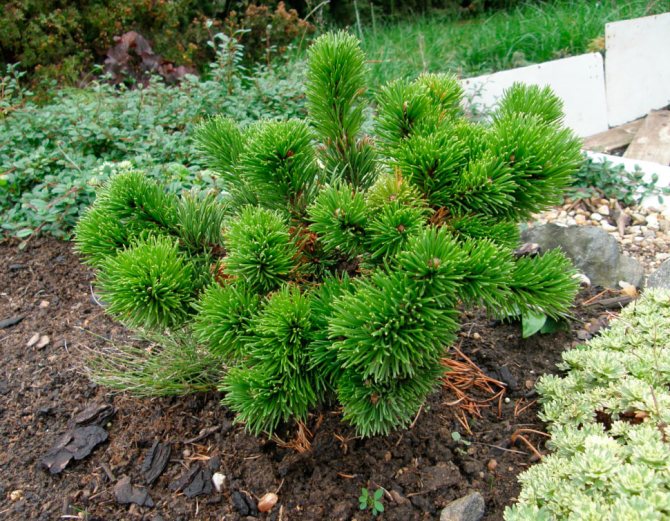

Pinus mugo jakobsen - Mini Pug grows up to 40 cm, is characterized by slow growth. Shrub variety with a round dark green crown of many short twigs.
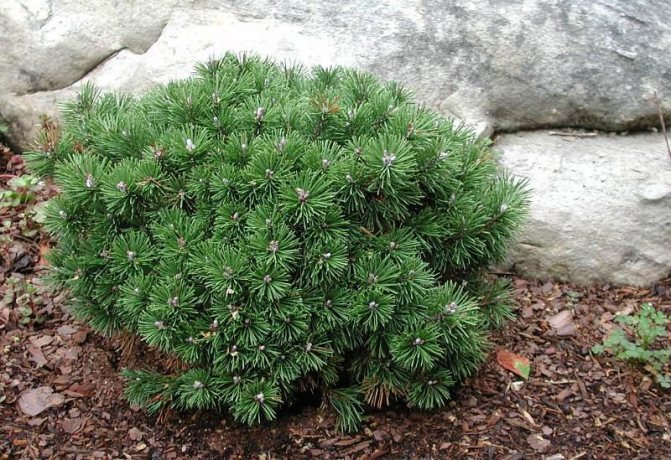

Pinus mugo Mini Mops - Benjamin is a dwarf, slow-growing shrub with a flat-globular crown. The height of an adult plant is 50-100 cm. The needles are short, tough, dark green in color, shiny.


Pinus mugo benjamin
Common colored varieties:
- Lemon is a variety up to 50 cm high with soft needles of a bright golden lemon color.
- Ophir - a dwarf mountain pine (40 cm) has 4-7 cm long needles of yellow color at the top and on the sunny side, the rest of the mass is dark green.
- Zandert looks like a pyramid, reaching a height of 80 cm. In summer, the needles are bright green with yellowish tips, and in winter they turn completely bright golden.
- Winter Gold - height up to 1 m, needles are shiny, hard, light green, by autumn they acquire a yellow tint.
There are varieties above 1 m that are used for landscaping the landscape. The mountain pine Mugus grows up to 2-3 m, the crown is flattened, creeping, up to 3-4 m in diameter. Its strong root system allows it to be planted on steep slopes to protect it from landslides. A haircut can be shaped like a bonsai. The mountain pine Pumilio grows up to 1.5 m, up to 2-3 m wide. Coniferous needles are directed upward, cones are elongated, similar to a cone. The crown forms a dense green dome that descends to the ground. The variety is distinguished by its resistance to drought and frost, unpretentiousness to the soil.
How to propagate pine
Pine is propagated by seeds and grafts. Cuttings root extremely poorly (8–10%). To collect the seed, you need to wait until the tree is 6 years old. Small cones appear at the end of autumn every two years. The seeds are collected, dried, and then planted in the spring in pots with a sandy substrate.The soil must be pre-treated with fungicides.
Did you know? Pinus is the Latin name for pine, which literally translates as "rock". And all because the plant is able to take root even on bare stones.
Cuttings for grafting are harvested in April. The grafting procedure can be carried out in spring or summer, in August. In the spring, a dormant scion is grafted onto a rootstock that has started to grow. The grafted plant can be in a greenhouse or in an open field.


It is necessary to wait for the beginning of sap flow (the appearance of candles). Coniferous plants are grafted in stock. The junction is wrapped tightly. After the obvious beginning of the growth of the scion, the winding can be loosened, and after a few months it can be completely removed. If such a plant successfully survives the winter, then we can say that the grafting process was successful.
Pests and diseases
All plants that have needles instead of foliage are distinguished by good resistance to diseases and pests. But often young trees fall under the attack of misfortunes. They are negatively affected by birds, weather conditions, improper care. In a weakened state after a winter or a very humid summer, pine is affected by a fungal disease - shyute.
It is possible to stop the spread of infection with the help of treatment with copper-containing preparations. All affected parts of the plant are removed and burned. As a preventive measure, during a humid and hot summer, the shrub is sprayed with colloidal sulfur.
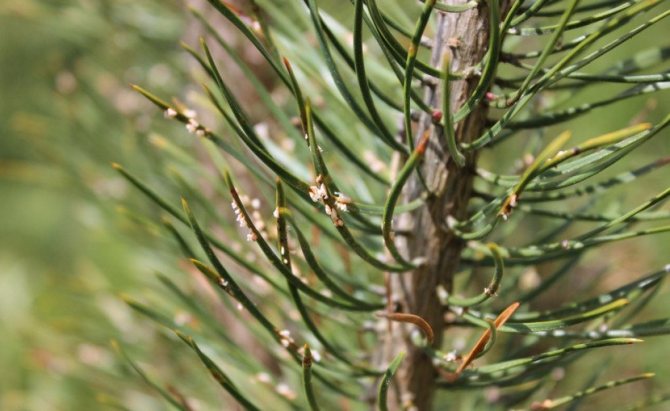

Because of it, the needles become brown to a black point, the branches often dry out and become covered with a spider web. The reason for this lies in insufficient hydration and lack of nutrients. A diseased tree may not look decorative at all, as it often loses many needles.
Another attack is scleroderriosis. It leads to the fact that at the top of the branches the buds begin to die off, and then the branches themselves. The diseased parts of the evergreen beauty must be cut off.
Severyanka is a disease that causes the appearance of an orange coating on the ends of the needles. It is caused by a rust fungus. It can only be defeated by completely removing the affected bushes.
We recommend that you learn about pine propagation methods.
Aphids are a common pest that spoils the beautiful appearance of pine. It is expelled by special drugs like "Lepidocide". It is imperative to carefully care for diseased trees so that they quickly recover.
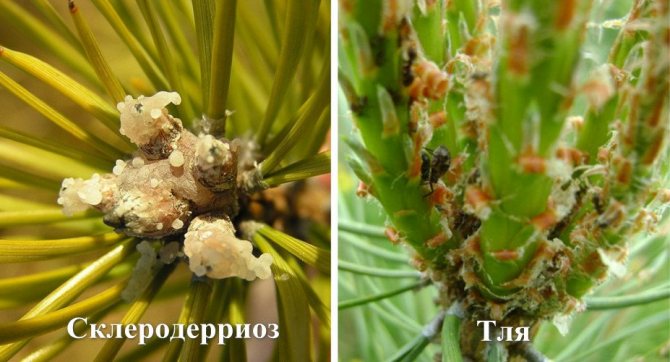

Description and dimensions of the tree
Mountain pine is a coniferous plant, tree or multi-stemmed branchy shrub. Usually not very high (up to 7–8 m), but sometimes it reaches 10 m. The branches and trunk are covered with gray-brown scaly bark, which peels off unevenly. Notable species characteristic: uneven bark shade throughout the tree.


It is darker at the bottom than at the top. Young shoots are initially light green, then turn dark brown, and then completely purple-brown. The needles are dark green, slightly glossy, densely covering the shoots. The needles are slightly twisted or curved.
Did you know? There are about 200 species of pines in the world, half of which grow on the territory of Russia.
The flowering period is late May - early June. At this time, the plant is greatly transformed. Beautiful yellow and pink male spikelets appear near the base, decorating the bush. Female cones open on a short straight leg. Cones are single or paired, triple. They are 2–7 cm long and 1.5–2 cm wide. The seeds in them are small, dark, ovoid. Cones ripen at the end of next year. Only pine over 6-10 years old can bloom and bear fruit. Mountain pines live for about 1000 years.

